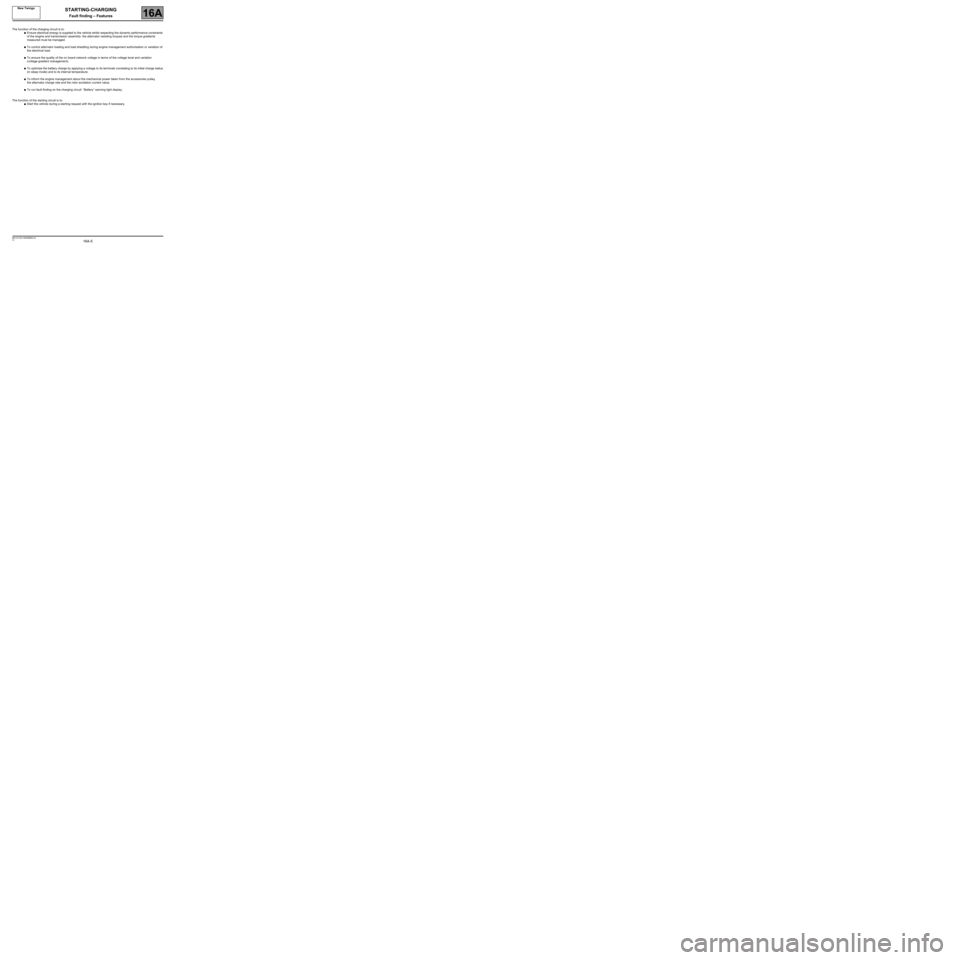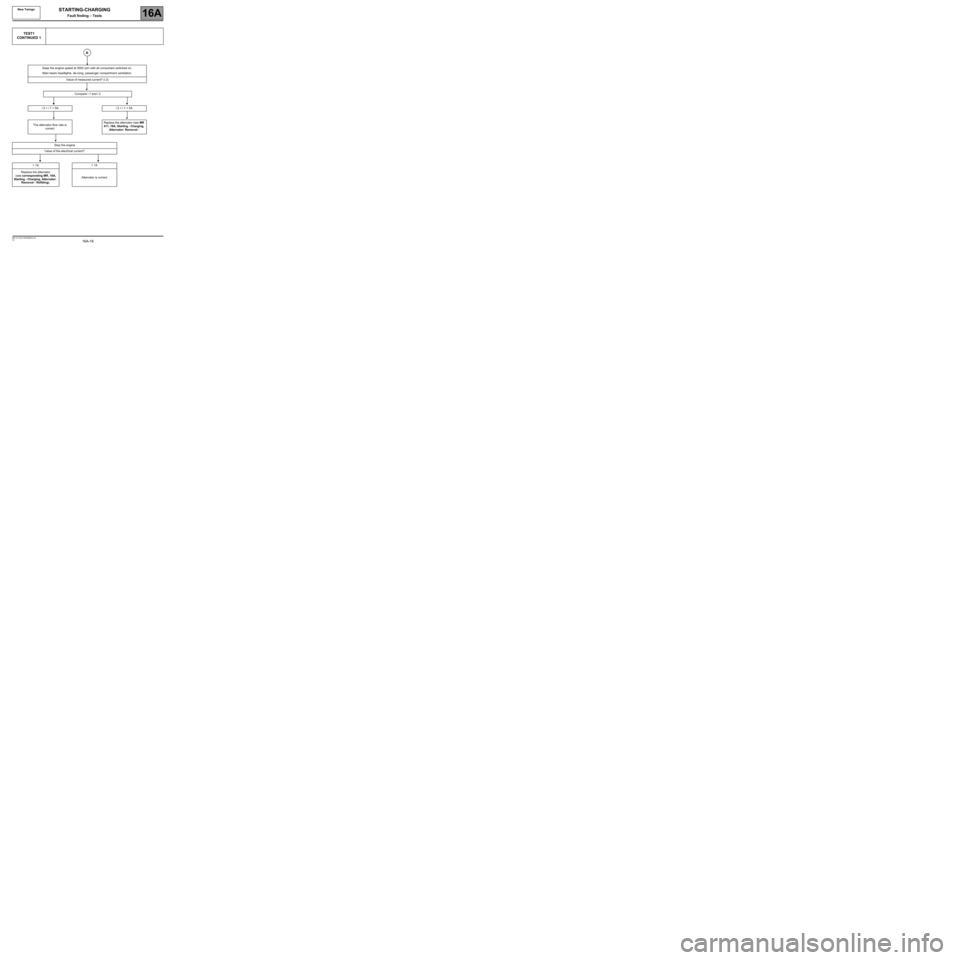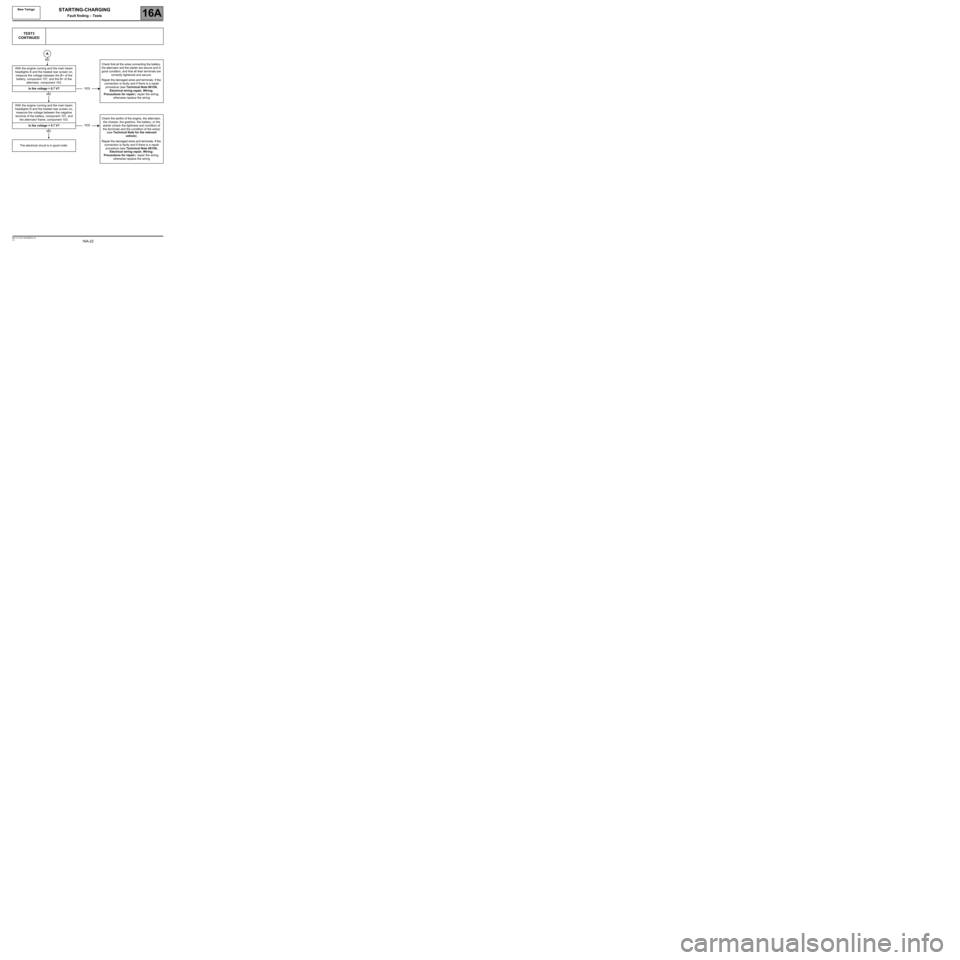light RENAULT TWINGO RS 2009 2.G Engine Starting Charging Workshop Manual
[x] Cancel search | Manufacturer: RENAULT, Model Year: 2009, Model line: TWINGO RS, Model: RENAULT TWINGO RS 2009 2.GPages: 22
Page 5 of 22

16A-5
MR-413-X44-16A000$500.mif
V2
16A
STARTING-CHARGING
Fault finding – Features
The function of the charging circuit is to:
●Ensure electrical energy is supplied to the vehicle whilst respecting the dynamic performance constraints
of the engine and transmission assembly: the alternator resisting torques and the torque gradients
measured must be managed.
●To control alternator loading and load shedding during engine management authorisation or variation of
the electrical load.
●To ensure the quality of the on board network voltage in terms of the voltage level and variation
(voltage gradient management).
●To optimise the battery charge by applying a voltage to its terminals correlating to its initial charge status
(in sleep mode) and to its internal temperature.
●To inform the engine management about the mechanical power taken from the accessories pulley,
the alternator charge rate and the rotor excitation current value.
●To run fault finding on the charging circuit: “Battery” warning light display.
The function of the starting circuit is to:
●Start the vehicle during a starting request with the ignition key if necessary. New Twingo
MR-413-X44-16A000$500.mif
Page 15 of 22

16A-15V2 MR-413-X44-16A000$750.mif
STARTING-CHARGING
Fault finding – Fault finding charts16A
New Twingo
ALP4The starter rotates slowly from the outset.
The rotation speed of the starter decreases rapidly.
The starter causes the warning lights on the instrument panel to
become very dim
Applicability: All types
NOTESTest the wiring (TEST3).
Test the status of the battery (see 80A, Battery).
If the fault is still present, replace the starter (see MR 411, 16A, Starting - Charging, Starter: Removal -
Refitting).
Page 18 of 22

16A-18V2 MR-413-X44-16A000$875.mif
STARTING-CHARGING
Fault finding – Tests16A
New Twingo
TEST1
CONTINUED 1
Keep the engine speed at 3000 rpm with all consumers switched on.
Main beam headlights, de-icing, passenger compartment ventilation.
Value of measured current? (i 2)
Compare i 1 and i 2
i 2 > i 1 + 5A i 2 < i 1 + 5A
The alternator flow rate is
correctReplace the alternator (see MR
411, 16A, Starting - Charging,
Alternator: Removal -
Stop the engine
Value of the electrical current?
> 1A < 1A
Replace the alternator
(see corresponding MR, 16A,
Starting - Charging, Alternator:
Removal - Refitting).Alternator is correct
A
Page 22 of 22

16A-22V2 MR-413-X44-16A000$875.mif
STARTING-CHARGING
Fault finding – Tests16A
New Twingo
TEST3
CONTINUED
Check that all the wires connecting the battery,
the alternator and the starter are secure and in
good condition, and that all their terminals are
correctly tightened and secure.
Repair the damaged wires and terminals. If the
connection is faulty and if there is a repair
procedure (see Technical Note 6015A,
Electrical wiring repair, Wiring:
Precautions for repair), repair the wiring,
otherwise replace the wiring With the engine running and the main beam
headlights lit and the heated rear screen on,
measure the voltage between the B+ of the
battery, component 107, and the B+ of the
alternator, component 103.
Is the voltage > 0.7 V?
With the engine running and the main beam
headlights lit and the heated rear screen on,
measure the voltage between the negative
terminal of the battery, component 107, and
the alternator frame, component 103.Check the earths of the engine, the alternator,
the chassis, the gearbox, the battery, or the
starter (check the tightness and condition of
the terminals and the condition of the wires)
(see Technical Note for the relevant
vehicle).
Repair the damaged wires and terminals. If the
connection is faulty and if there is a repair
procedure (see Technical Note 6015A,
Electrical wiring repair, Wiring:
Precautions for repair), repair the wiring,
otherwise replace the wiring Is the voltage > 0.7 V?
The electrical circuit is in good order.
A
NO
YES
NO
YES
NO